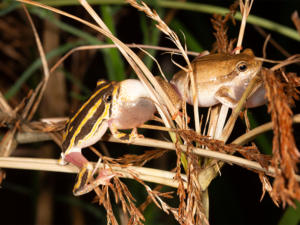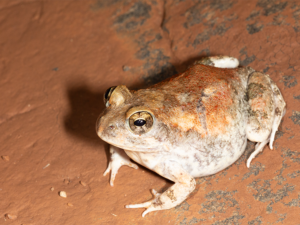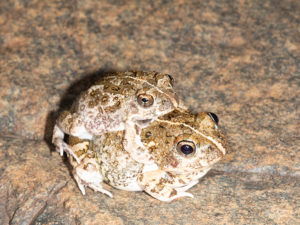Flood Brings Frogs to Life at Medike
By Darren Pieterse, Medike Nature Reserve and Ecology Manager: Soutpansberg Protected Area
Following the recent good rains on the EWT Medike Reserve and the Soutpansberg in general, the Sand River came down in flood for the first time in two years. Almost instantly, a cacophony of amphibian calls accompanied the rising water level. Amphibians are well-known to rapidly take advantage of suitable conditions for breeding, as they never know when the next opportunity may occur, and most species’ eggs and tadpoles are reliant on water to complete their initial life stage (until they metamorphosise into terrestrial froglets that are less reliant on water). Calls are useful for researchers as each species’ call is unique, although some species, such as Tandy’s, Tremolo and Cryptic Sand Frogs, cannot be reliably told apart based on external characteristics. This means that calls or DNA are required to make a positive identification.
Amphibians play a critical role in the ecosystem. They mostly prey on insects such as the flying ants, which abounded during our survey. They, in turn, are eaten by a variety of mammals, birds and snakes. Amphibians are also a good indicator of ecosystem health. Because frog skin is very porous to allow water to be absorbed and carbon dioxide to be released (the skin of toads is less porous), frogs are sensitive to chemicals such as industrial pollutants. As such, frogs are rarely found in areas with chemical pollution.
The recent onset of frog activity was an ideal opportunity for us to assess what species occur on Medike Reserve, and to get an indication of ecosystem health. During our survey, we recorded 14 different species (although the reserve’s list currently stands at 23 species). None of the species recorded are threatened, although the relatively high species diversity does suggest that the freshwater system is still healthy. Two threatened species are expected to occur on Medike Reserve, one of which is only found on the Soutpansberg and nowhere else on earth. We will continue looking for these and additional species.
Of the species recorded, the Red-banded Rubber Frog is the most interesting, as it exudes toxins from its skin to dissuade predators from eating it. It advertises its toxic state through its bright black-and-red colouration, known as aposematic colouration. This frog exudes cardiotoxins (toxins that affect the heart) from its skin, so if you’re going to kiss a frog in the hopes that it will become a prince (or princess), it’s probably best not to kiss this frog.

Painted Reed Frog – Hyperolius marmoratus

African Bullfrog – Pyxicephalus edulis

Banded Rubber Frog- Phrynomantis bifasciatus

Plain Grass Frog – Ptychadena anchietae

Bubbling Kassina – Kassina senegalensis

Russet-backed Sand Frog – Tomopterna marmorata

Eastern Red Toad – Schismaderma carens

Southern Foam-nest Frog – Chiromantis xerampelina

Northern Pygmy Toad – Poyntonophrynus fenoulheti

Tremolo Sand Frog – Tomopterna adiastola – Pair in amplexus
